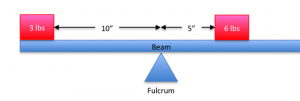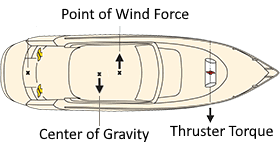The first question most people ask when sizing a bow thruster is “How much thrust do I need?” The question is obvious. Clearly, the bigger the boat the more thrust required to move it.
However, unlike primary propulsion, in which the goal is to propel the entire vessel from one point to another, the thruster’s job is to change the orientation, or Attitude, of a vessel around it’s center of effort, or the aggregate of the Center of Wind Force and Center of Gravity, also referred to as the Center of Rotational Effect. Too much of a good thing is not always a good thing, so a better question to ask is “How much thrust is required to change the orientation of my boat?”
We have Archimedes to thank for the principle that determines the mass of our vessels, or their displacement, which is famously known as “Archmiedes’ Principal”. A lesser known maritime contribution made by Archimedes was his work on the use of levers and the mathematical description of Torque. Torque can be described as twisting force, and twisting the boat around it’s Center of Rotational Effect, or CRE, is precisely what we want to do with a thruster.
Every good boater is familiar with the idea of leverage. Leverage is simply the application of a given force around a fulcrum, and in a zero wind condition, the fulcrum for changing boat attitude is CG. If we know the distance from a given point where we apply force, referred to as the Arm, a calculation can be made for Torque, or Moment. A simple way to think of this is to imagine weights on a beam:

The lbs of weight on the beam above represent the lbs of Thrust produced by two different thrusters working in opposition to one another around the CG of a boat. Yet, all though the 6 lb weight on the right is twice that of the 3 lb weight on the left, the two weights do the same amount of work. This is because the Moment remains the same by changing the Arm. The calculation can be represented as: 3lbs x 10″ = 6lbs x 5″ In other words, the Moment is the same on either side of the fulcrum at 30 inch/lbs. If we substitute the weights with 30lb and 60lb thrusters, and the beam distance with how far forward or aft a bow and stern thruster were installed on opposite sides of the boat, we would find that the force of the 30lb thruster could equal the 60lb thruster at 300 ft/lbs of Torque, and the boat would not rotate.
Here in lies one of the secrets of the efficiency of the Jet Thruster system. Unlike conventional thrusters, which must be installed far enough away from the bow or stern to facilitate installation and prevent a feedback loop, the Jet Thruster nozzle can be installed as far forward or aft as the hull shape will allow, with no regard to depth and great flexibility in hose placement.
In the example of the typical 36 foot boat with a 12,000 lb displacement, and a CG approximately 3/5 of the way back from the leading edge of the bow, a Jet Thruster nozzle installed 6 feet further forward than a comparable tunnel thruster will produce 50% more Torque. So in our example, a 50kgf Jet Thruster would do the same work as a 75kgf tunnel thruster.
Of course, no two boats are alike, and as wind conditions change, the CRE will move, but in most conditions the CRE remains somewhat near the CG, and the principals in any given condition always remain the same. Remember, when choosing a thruster for your boat, you must consider where the thruster system will apply the force, as much as you consider how much force you need in the system.


Recent Comments